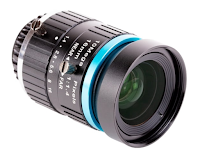With the release of the new Raspberry Pi High Quality Camera, you have the option to use different CS-mount senses with your Raspberry Pi. The High Quality Camera is a 12,3 M sensor with a 7.9 diagonal image size, enough for hobby projects and learn about digital photography.
Take a look in the official product page: https://www.raspberrypi.org/products/raspberry-pi-high-quality-camera/?resellerType=home
The camera have a CS-mount ring adapter and a C-mount, I remember the first time that I got the camera, and when playing with the 9 min and 16 min lenses I got frustrated because I don't remember that you have to use the ring adapter for the 16 min.Check the official documentation to see how to mount the adapter ring for different lenses.
Camera SpecificationSensor: 12,3 megapixels
Output: RAW, COMP8
Back Focus: 12.5 mm - 22.4 mm
Lens Standard: CS mount, C-mount ( C-CS adapter included )
Tripod mount: 1/4"
LENSES
A lens is a device that have a different amount of lenses inside, divergent and convergent, and with the most cases you can modify the shutter and the focus, there are 3 main topic that you have to adapt to take in consideration before you capture a photograph:
- Luminosity,
- F number,
- Focal distance,
In this picture, you can see the vision angle of different lens focal distance. You can see the relation between a focal distance of the lens and the vision angle raised by the following type of lenses; the numbers of the bellow diagram represent the following lens type:
1.- Fish Eye, an extreme wide-angle lens with a strongly convex front element.
2.- Wide angle lens,
a lens that reproduces perspective that generally looks "wider" than a normal lens.3.- Normal Lense, a lens with a focal length about equal to the diagonal size of the film or sensor format, or that reproduces perspective that generally looks "normal" to a human observer.
4.- Tele, an optically compressed version of the long-focus lens.
5.- Super Tele,
16mm C-Mount Lense
This lens provides a higher quality image than the 6 mm lens but it offer a narrow angle of view which is more suited to viewing distant objects.
This lense comes with a Back focus ring to adjust with a litter screw, you have to screwed it fully once mounted in the camera, this ring is to ensure that the focus will be hard fixed while you adjust the aperture or focus manually.
- Resolution: 10 mpx
- Picture Format: 1"
- Focus Distance: 17.53mm
- Aperture: F1.4-16
- Mount: C Type
- Dimensions: 39x50 mm
- Mode: Manual
- Minimum Macro Dist: 17.53mm
- Weigh: 133.7 gr.
- Angle View:
1" > 4.6°× 33.6°
2/3" > 30.0°× 23.2°
1/1.8" > 24.7°× 18.6°
1/2" > 21.8°× 16.4°
6mm CS Mount
This lens is the low cost Wide Range version of a raspberry pi lens for the new high quality camera, it's suitable for basic photography and it offer also the possibility to do macro photography because it can focus objects at very short distance.
- Resolution: 3 mpx
- Picture Format: 1/2"
- Focus Distance: 7.53mm
- Aperture: F1.2
- Mount: CS Type
- Minimum Macro Dist: 7.53mm
- Dimensions: 30x34 mm
- Mode: Manual
- Weigh: 53 gr.
- Angle View: 63º
What we can do with this lenses ?
If you check the previous diagram, you will see that we have 2 lens for our Raspberry, 16 mm and 6 mm, if you try to category by the lens type both have to be places as a type 1, Fish Eye type but there are more factors that we have to consider.
As you can see, the 6 mm lens is a basic one for normal photograph pictures. The 16 mm is a very good one but more expensive but it's not a real Tele lense like a large one that have a focus near to 135 mm.
Even that, if you would like to learn about photography bot are very good for it, and if you try to adjust them dynamically using a python program you will have a loot of options to play with Aperture, ISO, exposure, etc... for example to take long expose pictures.
Check this offer from Waveshare where they have other lenses avairables.
Waveshare Quality Industrial Telephoto Lens with 16mm Focal Length, Multi Field Angle and C-Mount Compatible with Raspberry Pi Camera…
- 16mm C-Mount Telephoto Lens For Raspberry Pi High Quality Camera
- 16mm Focal Length High Definition Telephoto Lens, Capturing Every Tiny Details
- Fitting The Lens To Raspberry Pi High Quality Camera (C-CS Adapter Required)
- To use with Raspberry Pi Zero, you need to buy an additional Raspberry Pi Zero v1.3 Camera Cable







